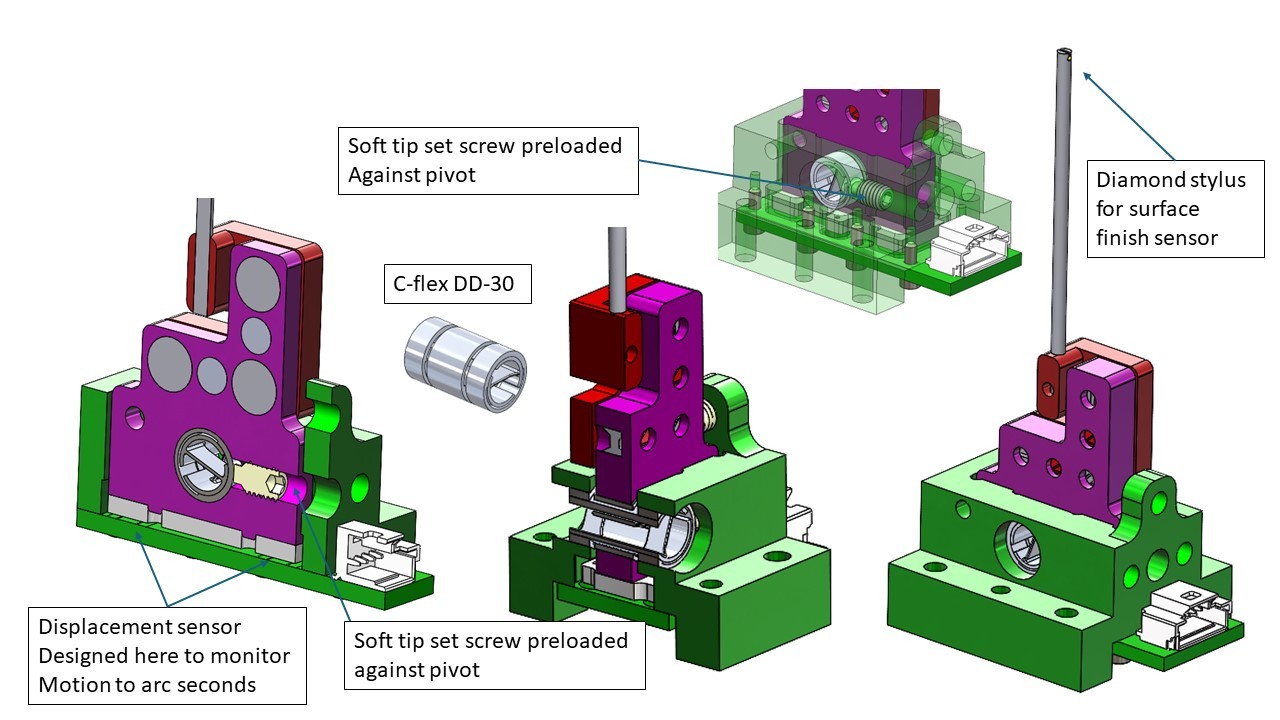IST Precision develops a wide range of industrial automation and high-end precision instrumentation devices. This article explores the critical role of flexure rotational pivots in achieving exceptional motion control within these instruments. IST in general uses these precision pivots in ultra precision applications including laser steering gimbals and surface profilometer sensors for the inspection industry.
 Introducing C-Flex: A Vendor in Precision Flexure Bearings
Introducing C-Flex: A Vendor in Precision Flexure Bearings
C-Flex [https://c-flex.com/] plays a vital role in our success. They are a valued vendor who supplies us with high-quality flexure bearings. These bearings enable frictionless and exceptionally precise motion in meticulously designed mechanical devices.
The Need for Frictionless Motion
In precision instrumentation, achieving smooth motion at the nanometer or sub-arc second level is paramount. Traditional bearings can introduce friction, leading to non-linear motion and errors in the nanometer range. This ultimately compromises instrument performance.
Several options exist for rotary-motion bearings, including air bearings, jeweled bearings, and ceramic bearings. While air bearings excel in achieving near-zero friction and smooth motion, they can be expensive to operate, requiring dry air and additional design space.
Flexure Bearings: A Compact and Cost-Effective Alternative
For applications with limited space (e.g., satellites) and small angular range requirements, flexure bearings offer an attractive alternative. They boast several advantages:
- Zero friction: Ensures smooth and highly linear motion.
- Compactness: Saves valuable space within the instrument.
- No air requirement: Eliminates the complexity and cost associated with dry air systems.
However, it’s important to note that flexure bearings typically have a small amount of rotational stiffness and a limited angular range which need to be accounted for in the design.
IST Precision: Experts in Flexure Design
While C-Flex doesn’t disclose the specific spring steel material and heat treatment used in their bearings, we understand the importance of exceptionally high yield stresses for flexure pivots. In critical applications, these pivots must maintain precise rotation angles over millions of cycles. In other flexure designs that IST designs we tend to use, materials like 17-4 SS with an H900 heat treatment, known for exceeding 1000 MPa yield stress. This enables the flexure mechanism to reach higher stresses leading to increased bearing life and capability to reach millions of rotational cycles.
Cost-Effective and Versatile
Flexure pivots are a cost-effective solution in a precision application, typically ranging from $50-$100 per pivot in low quantities. Pivot size is a key cost factor, with our designs often utilizing some of the smallest commercially available bearings (1/8 mm or 3.175 mm OD barrel size).
C-Flex: User-Friendly Features
The C-Flex website provides valuable resources for instrumentation designers, including information on bearing loads and clamping methods. We particularly appreciate their laser engraving of part numbers on the outer diameter of the pivots. This simple yet effective feature helps prevent mix-ups during assembly, especially when using multiple pivots with varying torsional rigidity.
Pivot Design Options
C-Flex offers two main pivot body types:
- Single End Bearing: One end is clamped to the device’s frame, while the other end flexes and rotates.
- Double End Bearing: Both ends are clamped to the frame, with the middle section free to flex and rotate.
The choice depends entirely on the specific application and instrument design. IST has experience utilizing both types of bearings in various projects.
Clamping Methods for Flexure Pivots
Here are three common clamping methods for flexure pivots:
- Squeeze Clamp: A traditional method that mechanically clamps around the pivot. While effective, it requires more space and often screws, which might not be ideal for all compact designs.
- Set Screws: An alternative method but carries the risk of pivot slippage. If using screws, opt for soft-tipped ones.
- Bonding:Offers the most compact approach and is ideal for designs requiring minimal parts. However, it also carries the highest risk since the bearings are permanent and can’t be removed during a prototype development phase of a project.
Featured Design: A Case Study in Precision for Surface Profilometer Sensors
The CAD model below showcases an interesting design utilizing a flexure bearing. This design features a small shaft (1.2 mm diameter) with a custom diamond tip bonded to its end. The shaft is part of a rotating mechanism that employs a flexure bearing pivot within the green body.
Using custom displacement sensors (differential capacitance sensors), we can detect motions of the shaft relative to the green body down to single digit nanometers. While the sensor itself is crucial, the flexure bearing enables frictionless and highly accurate movement of the shaft about the pivot’s rotational axis.
Furthermore, precision motion stages (not shown) allow our surface profilometer tip to scan along a surface. By monitoring the sensors with a very fast sampling rate (exceeding 10,000 samples per second), we can acquire detailed surface profile data. Ultimately, this design with the flexure pivot allows us to create a simple and elegant contact based profilometer sensor.

